Principles of Data Science for Business: FluffyGroCo Pest Report
VerifiedAdded on 2022/11/10
|12
|4121
|274
Report
AI Summary
This report assesses FluffyGroCo's briefing note on Crackety Crickling insect infestations affecting Truffula trees. It highlights deficiencies in the provided dataset, particularly regarding climate change data, and emphasizes the need for real-time data collection methods like sensors and weather reports. The investigation employs regression and correlation analyses to establish relationships between rainfall, temperature, and insect infestations. Results indicate a significant association between rain and infestations, with temperature also playing a crucial role. The report further discusses ethical and security considerations in data science applications and proposes potential data science-based solutions for smart pest management, including predictive, causal, and prescriptive analytics. The analysis reveals the proportions of infestations across different fields and the correlation between temperature and infestation, with recommendations for FluffyGroCo to monitor weather changes using technology to predict and control pest invasions.
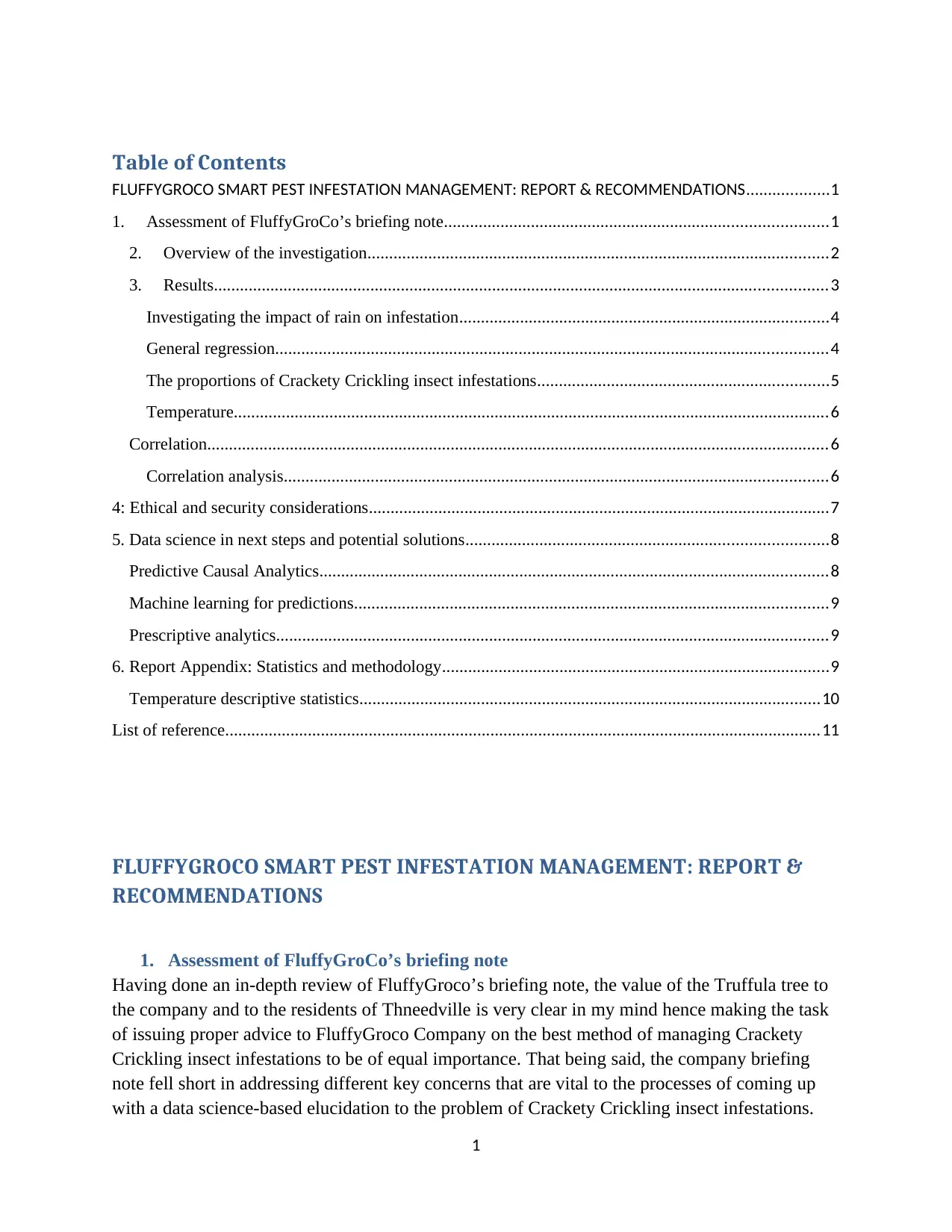
Table of Contents
FLUFFYGROCO SMART PEST INFESTATION MANAGEMENT: REPORT & RECOMMENDATIONS...................1
1. Assessment of FluffyGroCo’s briefing note........................................................................................1
2. Overview of the investigation..........................................................................................................2
3. Results.............................................................................................................................................3
Investigating the impact of rain on infestation.....................................................................................4
General regression...............................................................................................................................4
The proportions of Crackety Crickling insect infestations...................................................................5
Temperature.........................................................................................................................................6
Correlation...............................................................................................................................................6
Correlation analysis.............................................................................................................................6
4: Ethical and security considerations..........................................................................................................7
5. Data science in next steps and potential solutions...................................................................................8
Predictive Causal Analytics.....................................................................................................................8
Machine learning for predictions.............................................................................................................9
Prescriptive analytics...............................................................................................................................9
6. Report Appendix: Statistics and methodology.........................................................................................9
Temperature descriptive statistics..........................................................................................................10
List of reference.........................................................................................................................................11
FLUFFYGROCO SMART PEST INFESTATION MANAGEMENT: REPORT &
RECOMMENDATIONS
1. Assessment of FluffyGroCo’s briefing note
Having done an in-depth review of FluffyGroco’s briefing note, the value of the Truffula tree to
the company and to the residents of Thneedville is very clear in my mind hence making the task
of issuing proper advice to FluffyGroco Company on the best method of managing Crackety
Crickling insect infestations to be of equal importance. That being said, the company briefing
note fell short in addressing different key concerns that are vital to the processes of coming up
with a data science-based elucidation to the problem of Crackety Crickling insect infestations.
1
FLUFFYGROCO SMART PEST INFESTATION MANAGEMENT: REPORT & RECOMMENDATIONS...................1
1. Assessment of FluffyGroCo’s briefing note........................................................................................1
2. Overview of the investigation..........................................................................................................2
3. Results.............................................................................................................................................3
Investigating the impact of rain on infestation.....................................................................................4
General regression...............................................................................................................................4
The proportions of Crackety Crickling insect infestations...................................................................5
Temperature.........................................................................................................................................6
Correlation...............................................................................................................................................6
Correlation analysis.............................................................................................................................6
4: Ethical and security considerations..........................................................................................................7
5. Data science in next steps and potential solutions...................................................................................8
Predictive Causal Analytics.....................................................................................................................8
Machine learning for predictions.............................................................................................................9
Prescriptive analytics...............................................................................................................................9
6. Report Appendix: Statistics and methodology.........................................................................................9
Temperature descriptive statistics..........................................................................................................10
List of reference.........................................................................................................................................11
FLUFFYGROCO SMART PEST INFESTATION MANAGEMENT: REPORT &
RECOMMENDATIONS
1. Assessment of FluffyGroCo’s briefing note
Having done an in-depth review of FluffyGroco’s briefing note, the value of the Truffula tree to
the company and to the residents of Thneedville is very clear in my mind hence making the task
of issuing proper advice to FluffyGroco Company on the best method of managing Crackety
Crickling insect infestations to be of equal importance. That being said, the company briefing
note fell short in addressing different key concerns that are vital to the processes of coming up
with a data science-based elucidation to the problem of Crackety Crickling insect infestations.
1
Paraphrase This Document
Need a fresh take? Get an instant paraphrase of this document with our AI Paraphraser
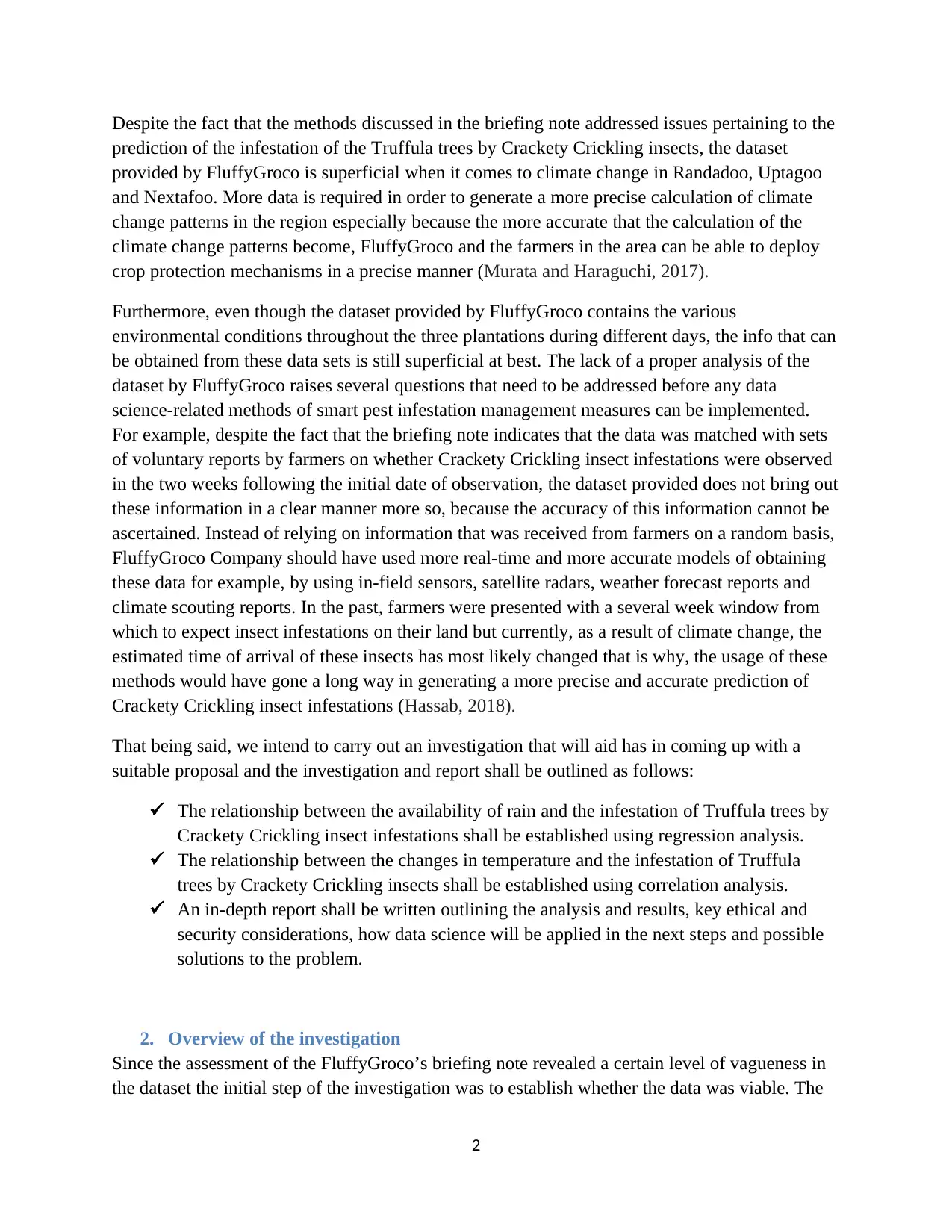
Despite the fact that the methods discussed in the briefing note addressed issues pertaining to the
prediction of the infestation of the Truffula trees by Crackety Crickling insects, the dataset
provided by FluffyGroco is superficial when it comes to climate change in Randadoo, Uptagoo
and Nextafoo. More data is required in order to generate a more precise calculation of climate
change patterns in the region especially because the more accurate that the calculation of the
climate change patterns become, FluffyGroco and the farmers in the area can be able to deploy
crop protection mechanisms in a precise manner (Murata and Haraguchi, 2017).
Furthermore, even though the dataset provided by FluffyGroco contains the various
environmental conditions throughout the three plantations during different days, the info that can
be obtained from these data sets is still superficial at best. The lack of a proper analysis of the
dataset by FluffyGroco raises several questions that need to be addressed before any data
science-related methods of smart pest infestation management measures can be implemented.
For example, despite the fact that the briefing note indicates that the data was matched with sets
of voluntary reports by farmers on whether Crackety Crickling insect infestations were observed
in the two weeks following the initial date of observation, the dataset provided does not bring out
these information in a clear manner more so, because the accuracy of this information cannot be
ascertained. Instead of relying on information that was received from farmers on a random basis,
FluffyGroco Company should have used more real-time and more accurate models of obtaining
these data for example, by using in-field sensors, satellite radars, weather forecast reports and
climate scouting reports. In the past, farmers were presented with a several week window from
which to expect insect infestations on their land but currently, as a result of climate change, the
estimated time of arrival of these insects has most likely changed that is why, the usage of these
methods would have gone a long way in generating a more precise and accurate prediction of
Crackety Crickling insect infestations (Hassab, 2018).
That being said, we intend to carry out an investigation that will aid has in coming up with a
suitable proposal and the investigation and report shall be outlined as follows:
The relationship between the availability of rain and the infestation of Truffula trees by
Crackety Crickling insect infestations shall be established using regression analysis.
The relationship between the changes in temperature and the infestation of Truffula
trees by Crackety Crickling insects shall be established using correlation analysis.
An in-depth report shall be written outlining the analysis and results, key ethical and
security considerations, how data science will be applied in the next steps and possible
solutions to the problem.
2. Overview of the investigation
Since the assessment of the FluffyGroco’s briefing note revealed a certain level of vagueness in
the dataset the initial step of the investigation was to establish whether the data was viable. The
2
prediction of the infestation of the Truffula trees by Crackety Crickling insects, the dataset
provided by FluffyGroco is superficial when it comes to climate change in Randadoo, Uptagoo
and Nextafoo. More data is required in order to generate a more precise calculation of climate
change patterns in the region especially because the more accurate that the calculation of the
climate change patterns become, FluffyGroco and the farmers in the area can be able to deploy
crop protection mechanisms in a precise manner (Murata and Haraguchi, 2017).
Furthermore, even though the dataset provided by FluffyGroco contains the various
environmental conditions throughout the three plantations during different days, the info that can
be obtained from these data sets is still superficial at best. The lack of a proper analysis of the
dataset by FluffyGroco raises several questions that need to be addressed before any data
science-related methods of smart pest infestation management measures can be implemented.
For example, despite the fact that the briefing note indicates that the data was matched with sets
of voluntary reports by farmers on whether Crackety Crickling insect infestations were observed
in the two weeks following the initial date of observation, the dataset provided does not bring out
these information in a clear manner more so, because the accuracy of this information cannot be
ascertained. Instead of relying on information that was received from farmers on a random basis,
FluffyGroco Company should have used more real-time and more accurate models of obtaining
these data for example, by using in-field sensors, satellite radars, weather forecast reports and
climate scouting reports. In the past, farmers were presented with a several week window from
which to expect insect infestations on their land but currently, as a result of climate change, the
estimated time of arrival of these insects has most likely changed that is why, the usage of these
methods would have gone a long way in generating a more precise and accurate prediction of
Crackety Crickling insect infestations (Hassab, 2018).
That being said, we intend to carry out an investigation that will aid has in coming up with a
suitable proposal and the investigation and report shall be outlined as follows:
The relationship between the availability of rain and the infestation of Truffula trees by
Crackety Crickling insect infestations shall be established using regression analysis.
The relationship between the changes in temperature and the infestation of Truffula
trees by Crackety Crickling insects shall be established using correlation analysis.
An in-depth report shall be written outlining the analysis and results, key ethical and
security considerations, how data science will be applied in the next steps and possible
solutions to the problem.
2. Overview of the investigation
Since the assessment of the FluffyGroco’s briefing note revealed a certain level of vagueness in
the dataset the initial step of the investigation was to establish whether the data was viable. The
2
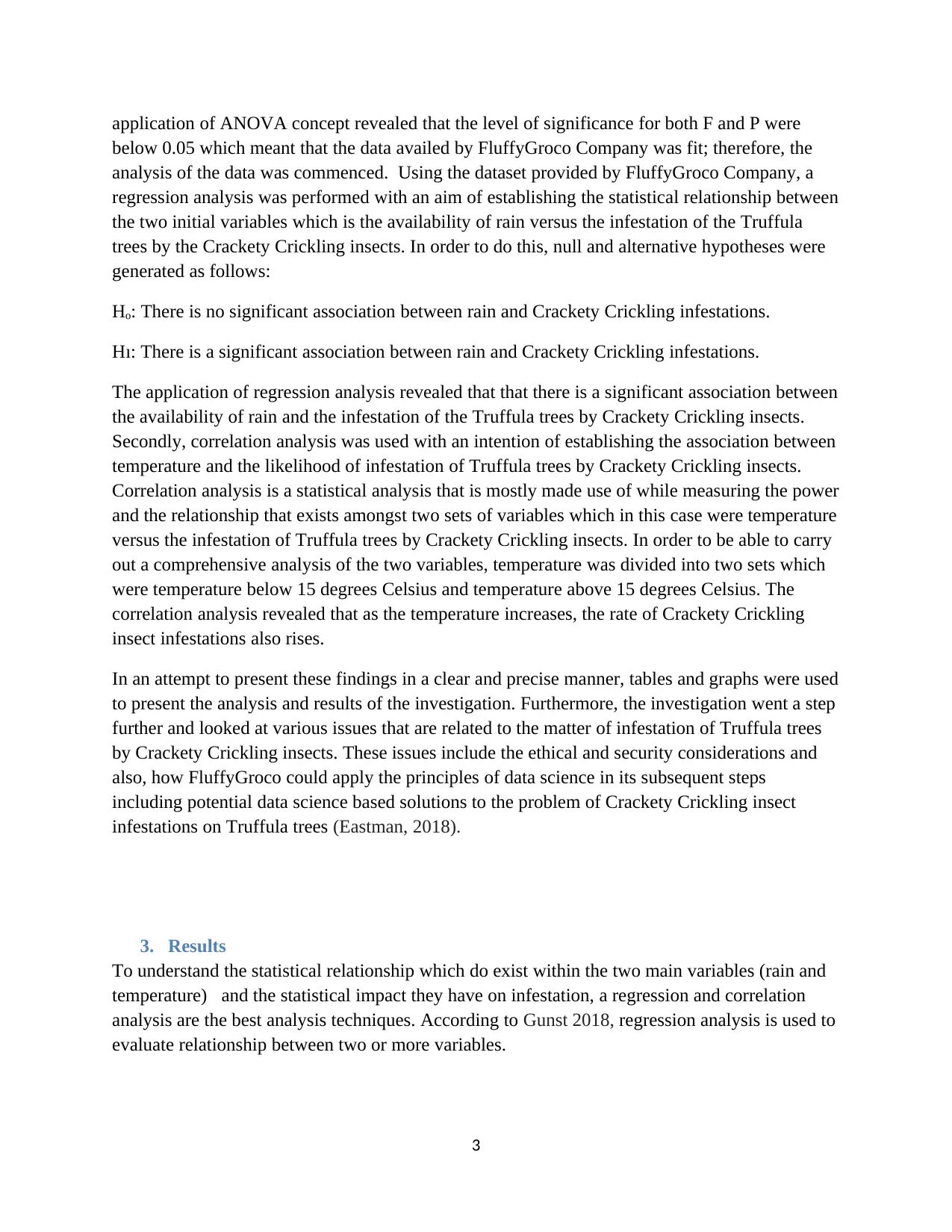
application of ANOVA concept revealed that the level of significance for both F and P were
below 0.05 which meant that the data availed by FluffyGroco Company was fit; therefore, the
analysis of the data was commenced. Using the dataset provided by FluffyGroco Company, a
regression analysis was performed with an aim of establishing the statistical relationship between
the two initial variables which is the availability of rain versus the infestation of the Truffula
trees by the Crackety Crickling insects. In order to do this, null and alternative hypotheses were
generated as follows:
Hₒ: There is no significant association between rain and Crackety Crickling infestations.
Hı: There is a significant association between rain and Crackety Crickling infestations.
The application of regression analysis revealed that that there is a significant association between
the availability of rain and the infestation of the Truffula trees by Crackety Crickling insects.
Secondly, correlation analysis was used with an intention of establishing the association between
temperature and the likelihood of infestation of Truffula trees by Crackety Crickling insects.
Correlation analysis is a statistical analysis that is mostly made use of while measuring the power
and the relationship that exists amongst two sets of variables which in this case were temperature
versus the infestation of Truffula trees by Crackety Crickling insects. In order to be able to carry
out a comprehensive analysis of the two variables, temperature was divided into two sets which
were temperature below 15 degrees Celsius and temperature above 15 degrees Celsius. The
correlation analysis revealed that as the temperature increases, the rate of Crackety Crickling
insect infestations also rises.
In an attempt to present these findings in a clear and precise manner, tables and graphs were used
to present the analysis and results of the investigation. Furthermore, the investigation went a step
further and looked at various issues that are related to the matter of infestation of Truffula trees
by Crackety Crickling insects. These issues include the ethical and security considerations and
also, how FluffyGroco could apply the principles of data science in its subsequent steps
including potential data science based solutions to the problem of Crackety Crickling insect
infestations on Truffula trees (Eastman, 2018).
3. Results
To understand the statistical relationship which do exist within the two main variables (rain and
temperature) and the statistical impact they have on infestation, a regression and correlation
analysis are the best analysis techniques. According to Gunst 2018, regression analysis is used to
evaluate relationship between two or more variables.
3
below 0.05 which meant that the data availed by FluffyGroco Company was fit; therefore, the
analysis of the data was commenced. Using the dataset provided by FluffyGroco Company, a
regression analysis was performed with an aim of establishing the statistical relationship between
the two initial variables which is the availability of rain versus the infestation of the Truffula
trees by the Crackety Crickling insects. In order to do this, null and alternative hypotheses were
generated as follows:
Hₒ: There is no significant association between rain and Crackety Crickling infestations.
Hı: There is a significant association between rain and Crackety Crickling infestations.
The application of regression analysis revealed that that there is a significant association between
the availability of rain and the infestation of the Truffula trees by Crackety Crickling insects.
Secondly, correlation analysis was used with an intention of establishing the association between
temperature and the likelihood of infestation of Truffula trees by Crackety Crickling insects.
Correlation analysis is a statistical analysis that is mostly made use of while measuring the power
and the relationship that exists amongst two sets of variables which in this case were temperature
versus the infestation of Truffula trees by Crackety Crickling insects. In order to be able to carry
out a comprehensive analysis of the two variables, temperature was divided into two sets which
were temperature below 15 degrees Celsius and temperature above 15 degrees Celsius. The
correlation analysis revealed that as the temperature increases, the rate of Crackety Crickling
insect infestations also rises.
In an attempt to present these findings in a clear and precise manner, tables and graphs were used
to present the analysis and results of the investigation. Furthermore, the investigation went a step
further and looked at various issues that are related to the matter of infestation of Truffula trees
by Crackety Crickling insects. These issues include the ethical and security considerations and
also, how FluffyGroco could apply the principles of data science in its subsequent steps
including potential data science based solutions to the problem of Crackety Crickling insect
infestations on Truffula trees (Eastman, 2018).
3. Results
To understand the statistical relationship which do exist within the two main variables (rain and
temperature) and the statistical impact they have on infestation, a regression and correlation
analysis are the best analysis techniques. According to Gunst 2018, regression analysis is used to
evaluate relationship between two or more variables.
3
⊘ This is a preview!⊘
Do you want full access?
Subscribe today to unlock all pages.

Trusted by 1+ million students worldwide
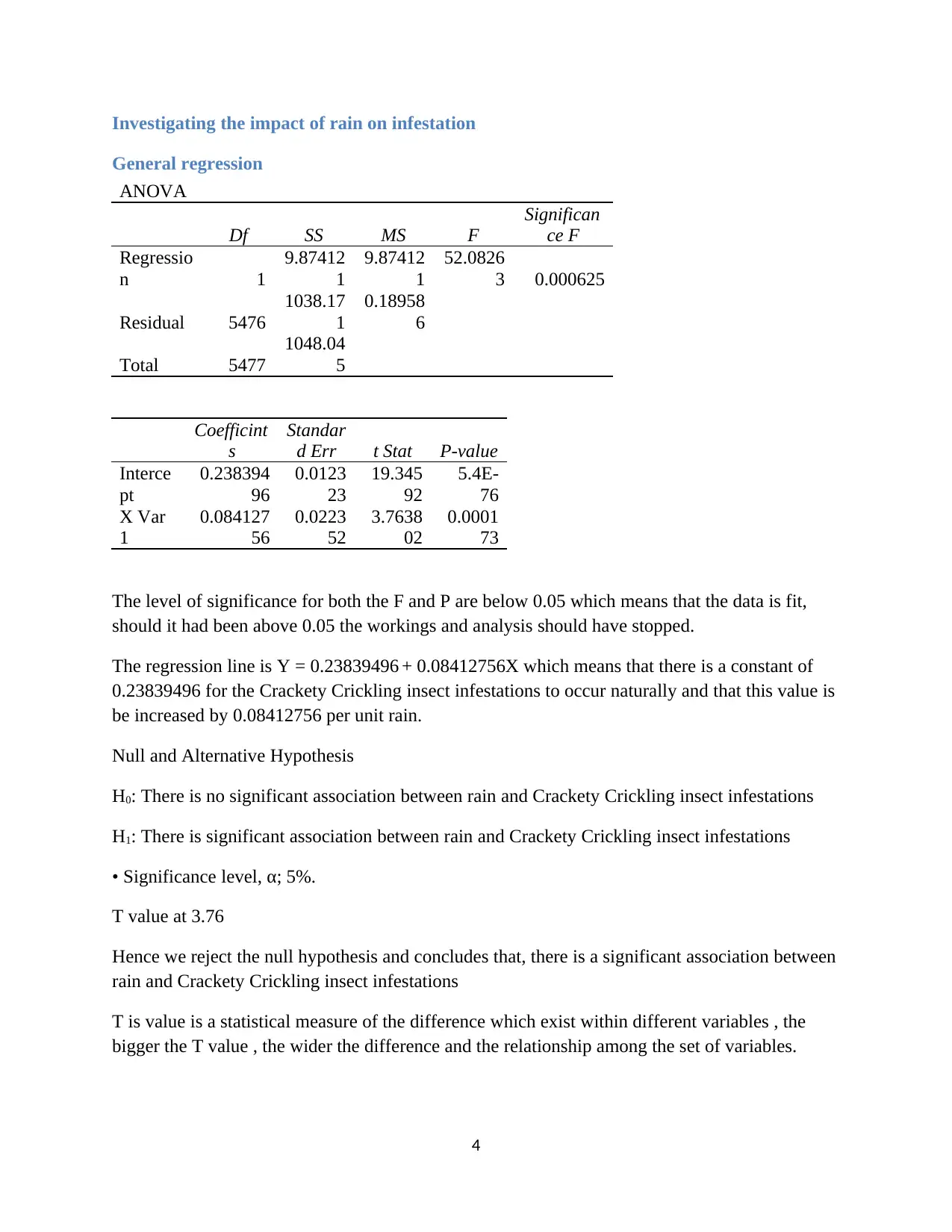
Investigating the impact of rain on infestation
General regression
ANOVA
Df SS MS F
Significan
ce F
Regressio
n 1
9.87412
1
9.87412
1
52.0826
3 0.000625
Residual 5476
1038.17
1
0.18958
6
Total 5477
1048.04
5
Coefficint
s
Standar
d Err t Stat P-value
Interce
pt
0.238394
96
0.0123
23
19.345
92
5.4E-
76
X Var
1
0.084127
56
0.0223
52
3.7638
02
0.0001
73
The level of significance for both the F and P are below 0.05 which means that the data is fit,
should it had been above 0.05 the workings and analysis should have stopped.
The regression line is Y = 0.23839496 + 0.08412756X which means that there is a constant of
0.23839496 for the Crackety Crickling insect infestations to occur naturally and that this value is
be increased by 0.08412756 per unit rain.
Null and Alternative Hypothesis
H0: There is no significant association between rain and Crackety Crickling insect infestations
H1: There is significant association between rain and Crackety Crickling insect infestations
• Significance level, α; 5%.
T value at 3.76
Hence we reject the null hypothesis and concludes that, there is a significant association between
rain and Crackety Crickling insect infestations
T is value is a statistical measure of the difference which exist within different variables , the
bigger the T value , the wider the difference and the relationship among the set of variables.
4
General regression
ANOVA
Df SS MS F
Significan
ce F
Regressio
n 1
9.87412
1
9.87412
1
52.0826
3 0.000625
Residual 5476
1038.17
1
0.18958
6
Total 5477
1048.04
5
Coefficint
s
Standar
d Err t Stat P-value
Interce
pt
0.238394
96
0.0123
23
19.345
92
5.4E-
76
X Var
1
0.084127
56
0.0223
52
3.7638
02
0.0001
73
The level of significance for both the F and P are below 0.05 which means that the data is fit,
should it had been above 0.05 the workings and analysis should have stopped.
The regression line is Y = 0.23839496 + 0.08412756X which means that there is a constant of
0.23839496 for the Crackety Crickling insect infestations to occur naturally and that this value is
be increased by 0.08412756 per unit rain.
Null and Alternative Hypothesis
H0: There is no significant association between rain and Crackety Crickling insect infestations
H1: There is significant association between rain and Crackety Crickling insect infestations
• Significance level, α; 5%.
T value at 3.76
Hence we reject the null hypothesis and concludes that, there is a significant association between
rain and Crackety Crickling insect infestations
T is value is a statistical measure of the difference which exist within different variables , the
bigger the T value , the wider the difference and the relationship among the set of variables.
4
Paraphrase This Document
Need a fresh take? Get an instant paraphrase of this document with our AI Paraphraser
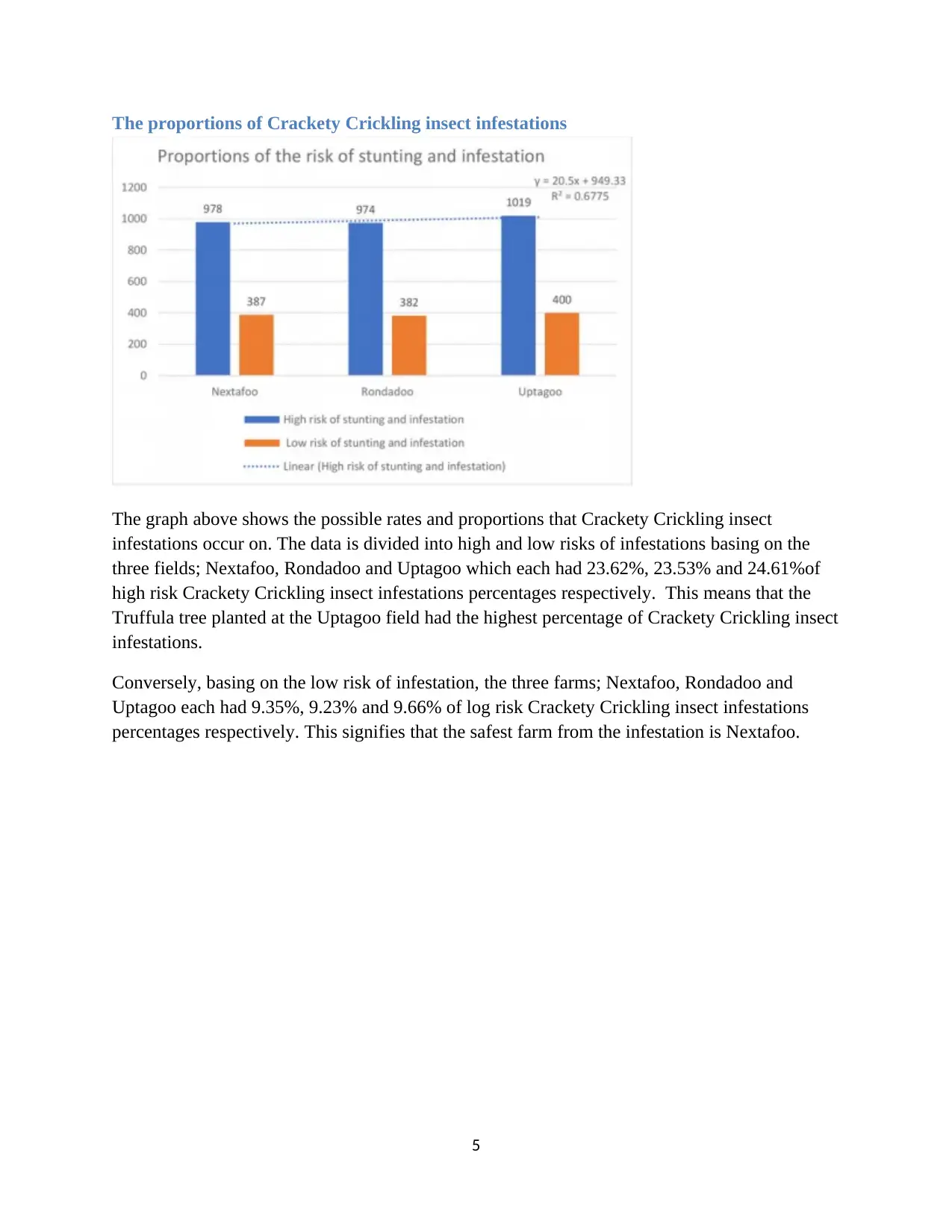
The proportions of Crackety Crickling insect infestations
The graph above shows the possible rates and proportions that Crackety Crickling insect
infestations occur on. The data is divided into high and low risks of infestations basing on the
three fields; Nextafoo, Rondadoo and Uptagoo which each had 23.62%, 23.53% and 24.61%of
high risk Crackety Crickling insect infestations percentages respectively. This means that the
Truffula tree planted at the Uptagoo field had the highest percentage of Crackety Crickling insect
infestations.
Conversely, basing on the low risk of infestation, the three farms; Nextafoo, Rondadoo and
Uptagoo each had 9.35%, 9.23% and 9.66% of log risk Crackety Crickling insect infestations
percentages respectively. This signifies that the safest farm from the infestation is Nextafoo.
5
The graph above shows the possible rates and proportions that Crackety Crickling insect
infestations occur on. The data is divided into high and low risks of infestations basing on the
three fields; Nextafoo, Rondadoo and Uptagoo which each had 23.62%, 23.53% and 24.61%of
high risk Crackety Crickling insect infestations percentages respectively. This means that the
Truffula tree planted at the Uptagoo field had the highest percentage of Crackety Crickling insect
infestations.
Conversely, basing on the low risk of infestation, the three farms; Nextafoo, Rondadoo and
Uptagoo each had 9.35%, 9.23% and 9.66% of log risk Crackety Crickling insect infestations
percentages respectively. This signifies that the safest farm from the infestation is Nextafoo.
5
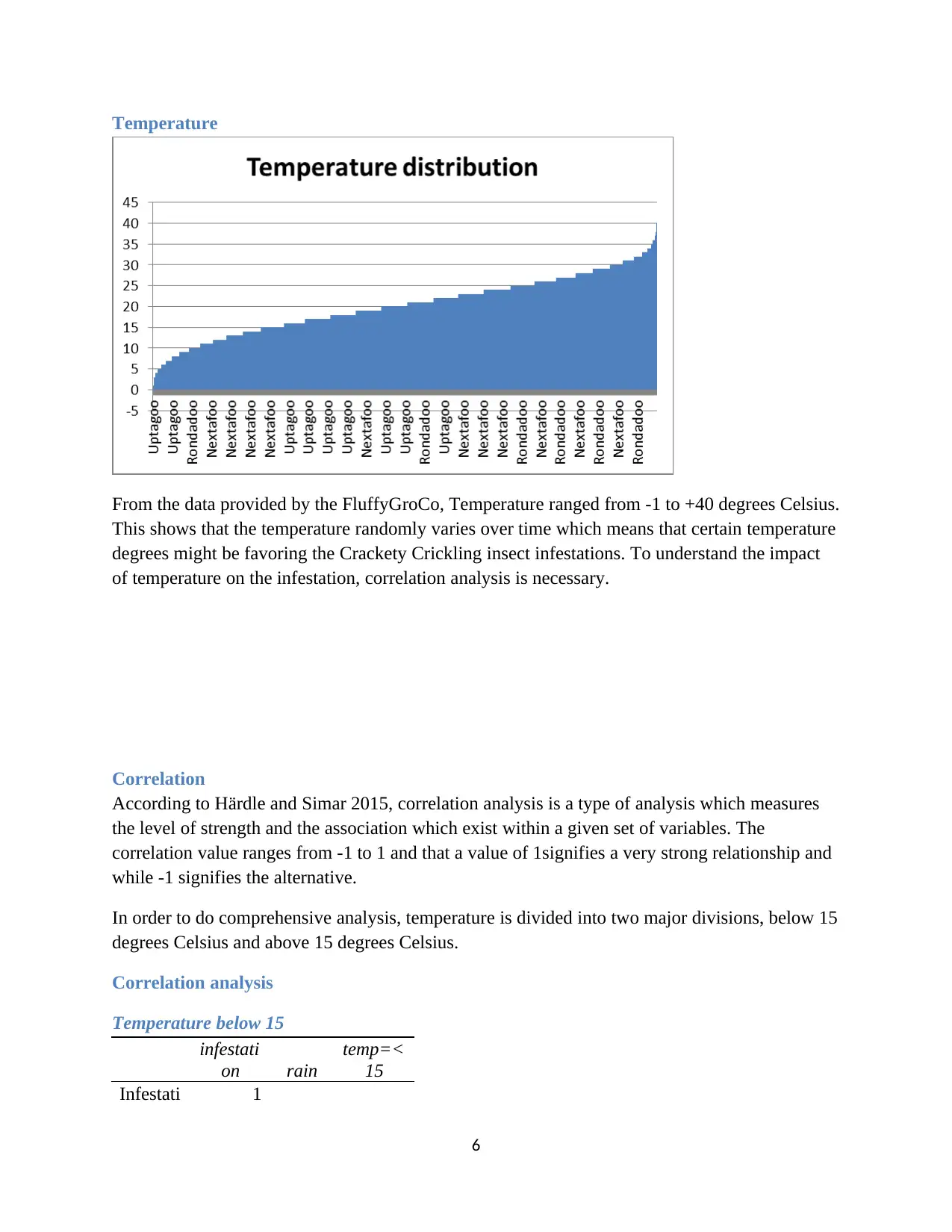
Temperature
From the data provided by the FluffyGroCo, Temperature ranged from -1 to +40 degrees Celsius.
This shows that the temperature randomly varies over time which means that certain temperature
degrees might be favoring the Crackety Crickling insect infestations. To understand the impact
of temperature on the infestation, correlation analysis is necessary.
Correlation
According to Härdle and Simar 2015, correlation analysis is a type of analysis which measures
the level of strength and the association which exist within a given set of variables. The
correlation value ranges from -1 to 1 and that a value of 1signifies a very strong relationship and
while -1 signifies the alternative.
In order to do comprehensive analysis, temperature is divided into two major divisions, below 15
degrees Celsius and above 15 degrees Celsius.
Correlation analysis
Temperature below 15
infestati
on rain
temp=<
15
Infestati 1
6
From the data provided by the FluffyGroCo, Temperature ranged from -1 to +40 degrees Celsius.
This shows that the temperature randomly varies over time which means that certain temperature
degrees might be favoring the Crackety Crickling insect infestations. To understand the impact
of temperature on the infestation, correlation analysis is necessary.
Correlation
According to Härdle and Simar 2015, correlation analysis is a type of analysis which measures
the level of strength and the association which exist within a given set of variables. The
correlation value ranges from -1 to 1 and that a value of 1signifies a very strong relationship and
while -1 signifies the alternative.
In order to do comprehensive analysis, temperature is divided into two major divisions, below 15
degrees Celsius and above 15 degrees Celsius.
Correlation analysis
Temperature below 15
infestati
on rain
temp=<
15
Infestati 1
6
⊘ This is a preview!⊘
Do you want full access?
Subscribe today to unlock all pages.

Trusted by 1+ million students worldwide
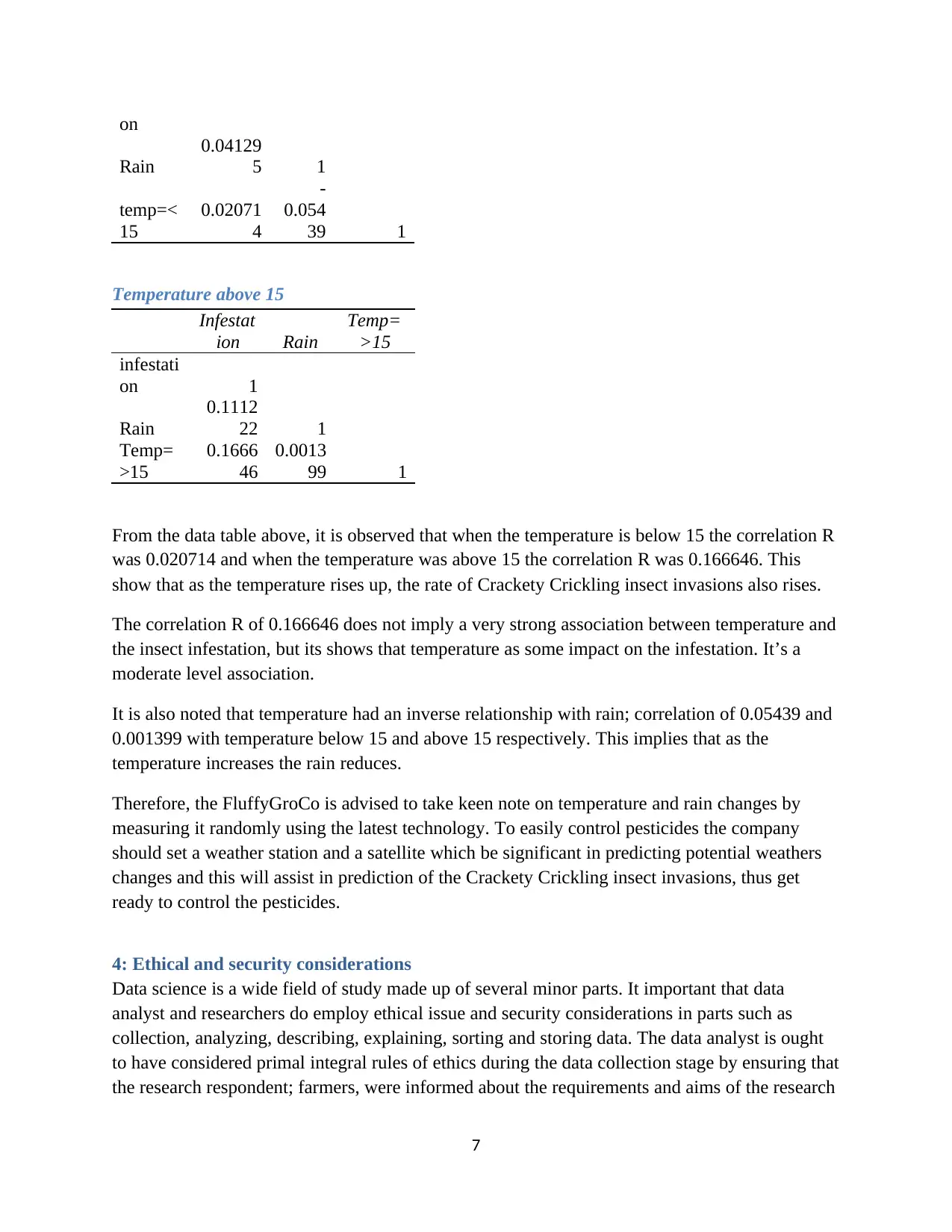
on
Rain
0.04129
5 1
temp=<
15
0.02071
4
-
0.054
39 1
Temperature above 15
Infestat
ion Rain
Temp=
>15
infestati
on 1
Rain
0.1112
22 1
Temp=
>15
0.1666
46
0.0013
99 1
From the data table above, it is observed that when the temperature is below 15 the correlation R
was 0.020714 and when the temperature was above 15 the correlation R was 0.166646. This
show that as the temperature rises up, the rate of Crackety Crickling insect invasions also rises.
The correlation R of 0.166646 does not imply a very strong association between temperature and
the insect infestation, but its shows that temperature as some impact on the infestation. It’s a
moderate level association.
It is also noted that temperature had an inverse relationship with rain; correlation of 0.05439 and
0.001399 with temperature below 15 and above 15 respectively. This implies that as the
temperature increases the rain reduces.
Therefore, the FluffyGroCo is advised to take keen note on temperature and rain changes by
measuring it randomly using the latest technology. To easily control pesticides the company
should set a weather station and a satellite which be significant in predicting potential weathers
changes and this will assist in prediction of the Crackety Crickling insect invasions, thus get
ready to control the pesticides.
4: Ethical and security considerations
Data science is a wide field of study made up of several minor parts. It important that data
analyst and researchers do employ ethical issue and security considerations in parts such as
collection, analyzing, describing, explaining, sorting and storing data. The data analyst is ought
to have considered primal integral rules of ethics during the data collection stage by ensuring that
the research respondent; farmers, were informed about the requirements and aims of the research
7
Rain
0.04129
5 1
temp=<
15
0.02071
4
-
0.054
39 1
Temperature above 15
Infestat
ion Rain
Temp=
>15
infestati
on 1
Rain
0.1112
22 1
Temp=
>15
0.1666
46
0.0013
99 1
From the data table above, it is observed that when the temperature is below 15 the correlation R
was 0.020714 and when the temperature was above 15 the correlation R was 0.166646. This
show that as the temperature rises up, the rate of Crackety Crickling insect invasions also rises.
The correlation R of 0.166646 does not imply a very strong association between temperature and
the insect infestation, but its shows that temperature as some impact on the infestation. It’s a
moderate level association.
It is also noted that temperature had an inverse relationship with rain; correlation of 0.05439 and
0.001399 with temperature below 15 and above 15 respectively. This implies that as the
temperature increases the rain reduces.
Therefore, the FluffyGroCo is advised to take keen note on temperature and rain changes by
measuring it randomly using the latest technology. To easily control pesticides the company
should set a weather station and a satellite which be significant in predicting potential weathers
changes and this will assist in prediction of the Crackety Crickling insect invasions, thus get
ready to control the pesticides.
4: Ethical and security considerations
Data science is a wide field of study made up of several minor parts. It important that data
analyst and researchers do employ ethical issue and security considerations in parts such as
collection, analyzing, describing, explaining, sorting and storing data. The data analyst is ought
to have considered primal integral rules of ethics during the data collection stage by ensuring that
the research respondent; farmers, were informed about the requirements and aims of the research
7
Paraphrase This Document
Need a fresh take? Get an instant paraphrase of this document with our AI Paraphraser
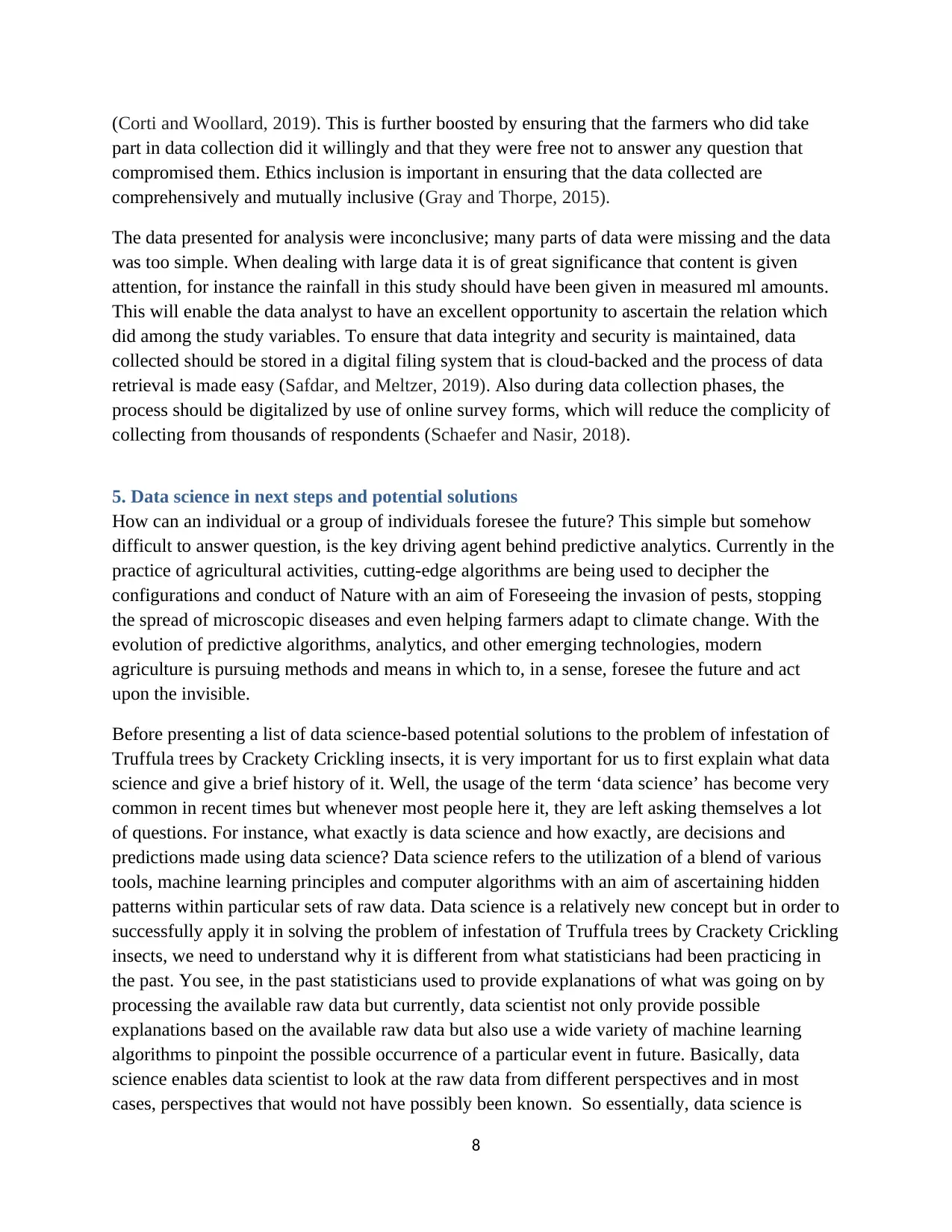
(Corti and Woollard, 2019). This is further boosted by ensuring that the farmers who did take
part in data collection did it willingly and that they were free not to answer any question that
compromised them. Ethics inclusion is important in ensuring that the data collected are
comprehensively and mutually inclusive (Gray and Thorpe, 2015).
The data presented for analysis were inconclusive; many parts of data were missing and the data
was too simple. When dealing with large data it is of great significance that content is given
attention, for instance the rainfall in this study should have been given in measured ml amounts.
This will enable the data analyst to have an excellent opportunity to ascertain the relation which
did among the study variables. To ensure that data integrity and security is maintained, data
collected should be stored in a digital filing system that is cloud-backed and the process of data
retrieval is made easy (Safdar, and Meltzer, 2019). Also during data collection phases, the
process should be digitalized by use of online survey forms, which will reduce the complicity of
collecting from thousands of respondents (Schaefer and Nasir, 2018).
5. Data science in next steps and potential solutions
How can an individual or a group of individuals foresee the future? This simple but somehow
difficult to answer question, is the key driving agent behind predictive analytics. Currently in the
practice of agricultural activities, cutting-edge algorithms are being used to decipher the
configurations and conduct of Nature with an aim of Foreseeing the invasion of pests, stopping
the spread of microscopic diseases and even helping farmers adapt to climate change. With the
evolution of predictive algorithms, analytics, and other emerging technologies, modern
agriculture is pursuing methods and means in which to, in a sense, foresee the future and act
upon the invisible.
Before presenting a list of data science-based potential solutions to the problem of infestation of
Truffula trees by Crackety Crickling insects, it is very important for us to first explain what data
science and give a brief history of it. Well, the usage of the term ‘data science’ has become very
common in recent times but whenever most people here it, they are left asking themselves a lot
of questions. For instance, what exactly is data science and how exactly, are decisions and
predictions made using data science? Data science refers to the utilization of a blend of various
tools, machine learning principles and computer algorithms with an aim of ascertaining hidden
patterns within particular sets of raw data. Data science is a relatively new concept but in order to
successfully apply it in solving the problem of infestation of Truffula trees by Crackety Crickling
insects, we need to understand why it is different from what statisticians had been practicing in
the past. You see, in the past statisticians used to provide explanations of what was going on by
processing the available raw data but currently, data scientist not only provide possible
explanations based on the available raw data but also use a wide variety of machine learning
algorithms to pinpoint the possible occurrence of a particular event in future. Basically, data
science enables data scientist to look at the raw data from different perspectives and in most
cases, perspectives that would not have possibly been known. So essentially, data science is
8
part in data collection did it willingly and that they were free not to answer any question that
compromised them. Ethics inclusion is important in ensuring that the data collected are
comprehensively and mutually inclusive (Gray and Thorpe, 2015).
The data presented for analysis were inconclusive; many parts of data were missing and the data
was too simple. When dealing with large data it is of great significance that content is given
attention, for instance the rainfall in this study should have been given in measured ml amounts.
This will enable the data analyst to have an excellent opportunity to ascertain the relation which
did among the study variables. To ensure that data integrity and security is maintained, data
collected should be stored in a digital filing system that is cloud-backed and the process of data
retrieval is made easy (Safdar, and Meltzer, 2019). Also during data collection phases, the
process should be digitalized by use of online survey forms, which will reduce the complicity of
collecting from thousands of respondents (Schaefer and Nasir, 2018).
5. Data science in next steps and potential solutions
How can an individual or a group of individuals foresee the future? This simple but somehow
difficult to answer question, is the key driving agent behind predictive analytics. Currently in the
practice of agricultural activities, cutting-edge algorithms are being used to decipher the
configurations and conduct of Nature with an aim of Foreseeing the invasion of pests, stopping
the spread of microscopic diseases and even helping farmers adapt to climate change. With the
evolution of predictive algorithms, analytics, and other emerging technologies, modern
agriculture is pursuing methods and means in which to, in a sense, foresee the future and act
upon the invisible.
Before presenting a list of data science-based potential solutions to the problem of infestation of
Truffula trees by Crackety Crickling insects, it is very important for us to first explain what data
science and give a brief history of it. Well, the usage of the term ‘data science’ has become very
common in recent times but whenever most people here it, they are left asking themselves a lot
of questions. For instance, what exactly is data science and how exactly, are decisions and
predictions made using data science? Data science refers to the utilization of a blend of various
tools, machine learning principles and computer algorithms with an aim of ascertaining hidden
patterns within particular sets of raw data. Data science is a relatively new concept but in order to
successfully apply it in solving the problem of infestation of Truffula trees by Crackety Crickling
insects, we need to understand why it is different from what statisticians had been practicing in
the past. You see, in the past statisticians used to provide explanations of what was going on by
processing the available raw data but currently, data scientist not only provide possible
explanations based on the available raw data but also use a wide variety of machine learning
algorithms to pinpoint the possible occurrence of a particular event in future. Basically, data
science enables data scientist to look at the raw data from different perspectives and in most
cases, perspectives that would not have possibly been known. So essentially, data science is
8
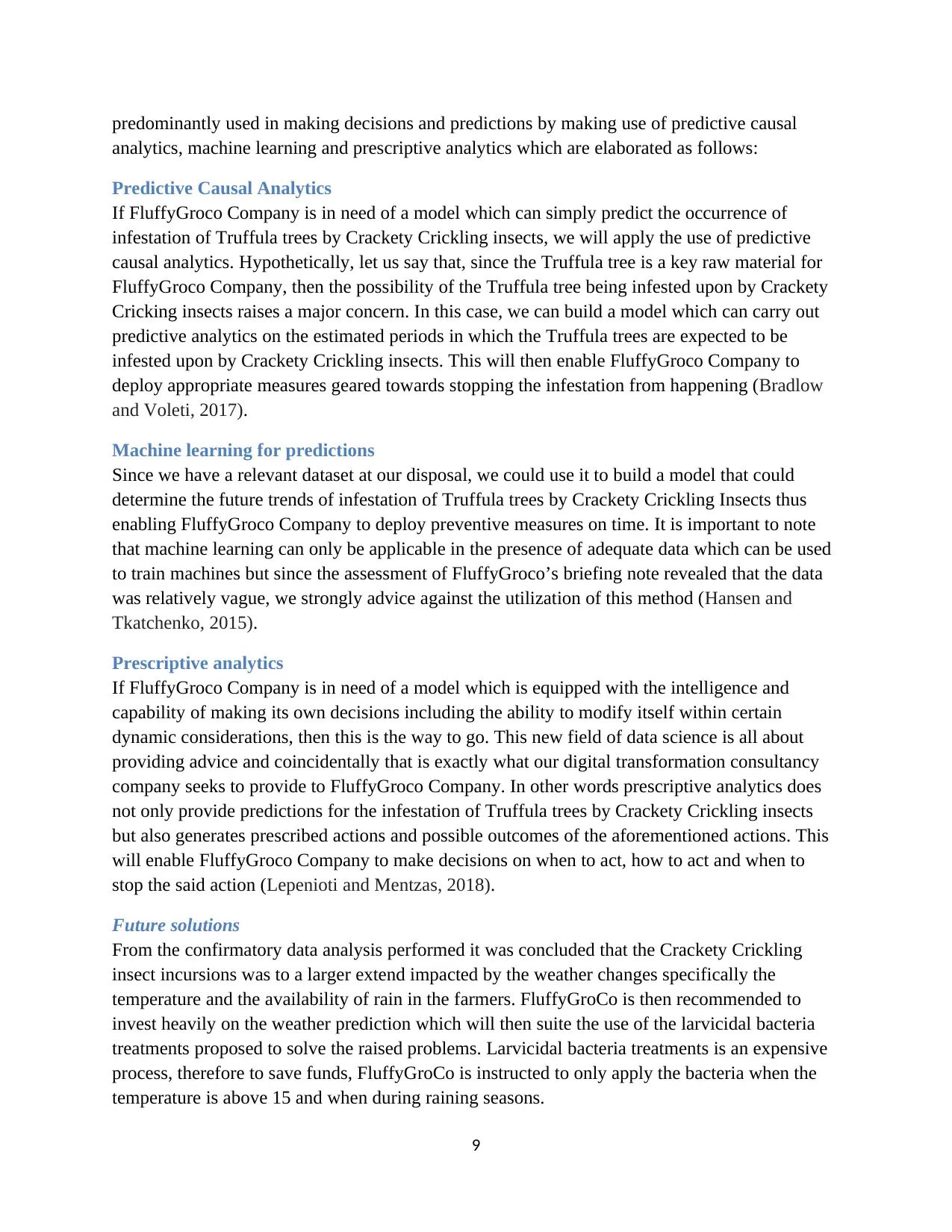
predominantly used in making decisions and predictions by making use of predictive causal
analytics, machine learning and prescriptive analytics which are elaborated as follows:
Predictive Causal Analytics
If FluffyGroco Company is in need of a model which can simply predict the occurrence of
infestation of Truffula trees by Crackety Crickling insects, we will apply the use of predictive
causal analytics. Hypothetically, let us say that, since the Truffula tree is a key raw material for
FluffyGroco Company, then the possibility of the Truffula tree being infested upon by Crackety
Cricking insects raises a major concern. In this case, we can build a model which can carry out
predictive analytics on the estimated periods in which the Truffula trees are expected to be
infested upon by Crackety Crickling insects. This will then enable FluffyGroco Company to
deploy appropriate measures geared towards stopping the infestation from happening (Bradlow
and Voleti, 2017).
Machine learning for predictions
Since we have a relevant dataset at our disposal, we could use it to build a model that could
determine the future trends of infestation of Truffula trees by Crackety Crickling Insects thus
enabling FluffyGroco Company to deploy preventive measures on time. It is important to note
that machine learning can only be applicable in the presence of adequate data which can be used
to train machines but since the assessment of FluffyGroco’s briefing note revealed that the data
was relatively vague, we strongly advice against the utilization of this method (Hansen and
Tkatchenko, 2015).
Prescriptive analytics
If FluffyGroco Company is in need of a model which is equipped with the intelligence and
capability of making its own decisions including the ability to modify itself within certain
dynamic considerations, then this is the way to go. This new field of data science is all about
providing advice and coincidentally that is exactly what our digital transformation consultancy
company seeks to provide to FluffyGroco Company. In other words prescriptive analytics does
not only provide predictions for the infestation of Truffula trees by Crackety Crickling insects
but also generates prescribed actions and possible outcomes of the aforementioned actions. This
will enable FluffyGroco Company to make decisions on when to act, how to act and when to
stop the said action (Lepenioti and Mentzas, 2018).
Future solutions
From the confirmatory data analysis performed it was concluded that the Crackety Crickling
insect incursions was to a larger extend impacted by the weather changes specifically the
temperature and the availability of rain in the farmers. FluffyGroCo is then recommended to
invest heavily on the weather prediction which will then suite the use of the larvicidal bacteria
treatments proposed to solve the raised problems. Larvicidal bacteria treatments is an expensive
process, therefore to save funds, FluffyGroCo is instructed to only apply the bacteria when the
temperature is above 15 and when during raining seasons.
9
analytics, machine learning and prescriptive analytics which are elaborated as follows:
Predictive Causal Analytics
If FluffyGroco Company is in need of a model which can simply predict the occurrence of
infestation of Truffula trees by Crackety Crickling insects, we will apply the use of predictive
causal analytics. Hypothetically, let us say that, since the Truffula tree is a key raw material for
FluffyGroco Company, then the possibility of the Truffula tree being infested upon by Crackety
Cricking insects raises a major concern. In this case, we can build a model which can carry out
predictive analytics on the estimated periods in which the Truffula trees are expected to be
infested upon by Crackety Crickling insects. This will then enable FluffyGroco Company to
deploy appropriate measures geared towards stopping the infestation from happening (Bradlow
and Voleti, 2017).
Machine learning for predictions
Since we have a relevant dataset at our disposal, we could use it to build a model that could
determine the future trends of infestation of Truffula trees by Crackety Crickling Insects thus
enabling FluffyGroco Company to deploy preventive measures on time. It is important to note
that machine learning can only be applicable in the presence of adequate data which can be used
to train machines but since the assessment of FluffyGroco’s briefing note revealed that the data
was relatively vague, we strongly advice against the utilization of this method (Hansen and
Tkatchenko, 2015).
Prescriptive analytics
If FluffyGroco Company is in need of a model which is equipped with the intelligence and
capability of making its own decisions including the ability to modify itself within certain
dynamic considerations, then this is the way to go. This new field of data science is all about
providing advice and coincidentally that is exactly what our digital transformation consultancy
company seeks to provide to FluffyGroco Company. In other words prescriptive analytics does
not only provide predictions for the infestation of Truffula trees by Crackety Crickling insects
but also generates prescribed actions and possible outcomes of the aforementioned actions. This
will enable FluffyGroco Company to make decisions on when to act, how to act and when to
stop the said action (Lepenioti and Mentzas, 2018).
Future solutions
From the confirmatory data analysis performed it was concluded that the Crackety Crickling
insect incursions was to a larger extend impacted by the weather changes specifically the
temperature and the availability of rain in the farmers. FluffyGroCo is then recommended to
invest heavily on the weather prediction which will then suite the use of the larvicidal bacteria
treatments proposed to solve the raised problems. Larvicidal bacteria treatments is an expensive
process, therefore to save funds, FluffyGroCo is instructed to only apply the bacteria when the
temperature is above 15 and when during raining seasons.
9
⊘ This is a preview!⊘
Do you want full access?
Subscribe today to unlock all pages.

Trusted by 1+ million students worldwide
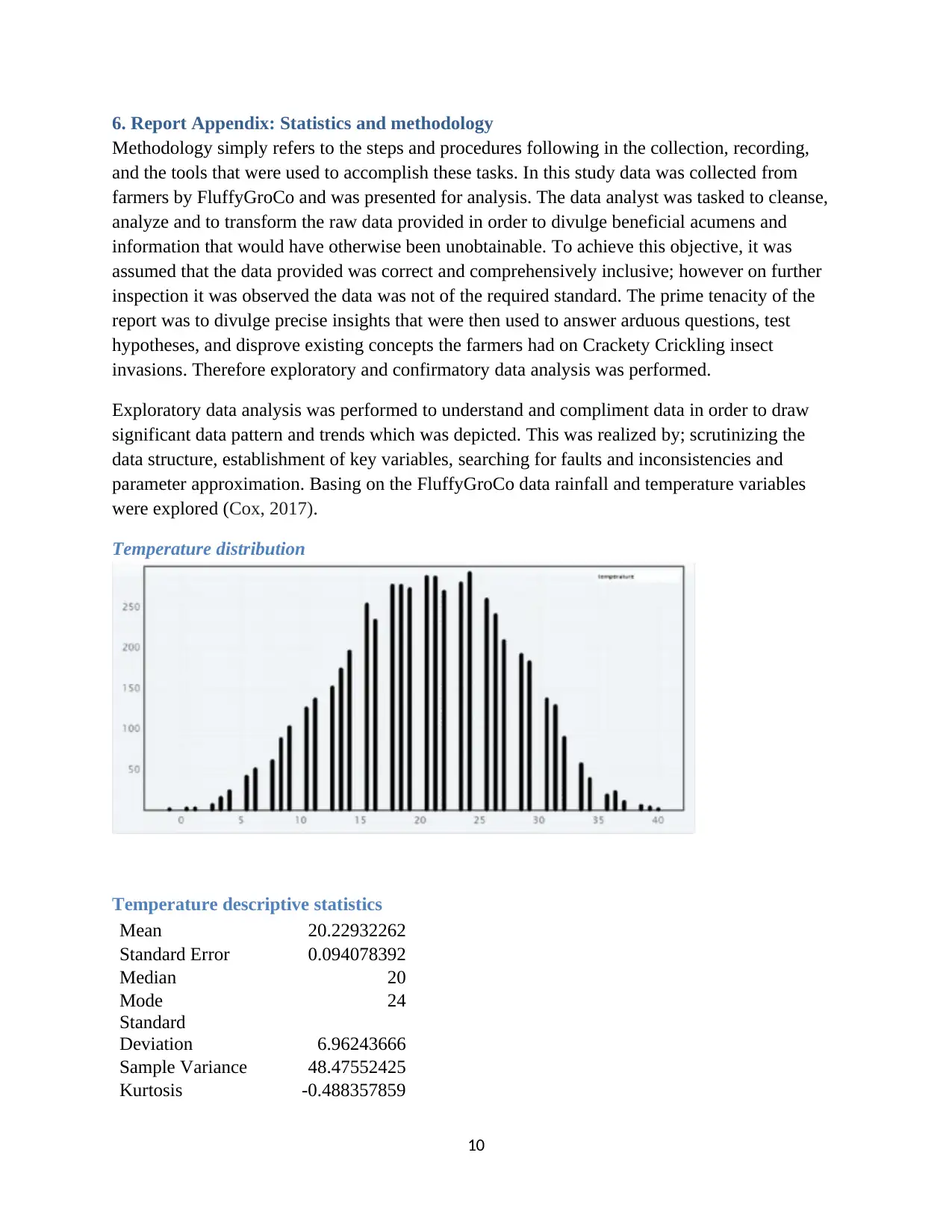
6. Report Appendix: Statistics and methodology
Methodology simply refers to the steps and procedures following in the collection, recording,
and the tools that were used to accomplish these tasks. In this study data was collected from
farmers by FluffyGroCo and was presented for analysis. The data analyst was tasked to cleanse,
analyze and to transform the raw data provided in order to divulge beneficial acumens and
information that would have otherwise been unobtainable. To achieve this objective, it was
assumed that the data provided was correct and comprehensively inclusive; however on further
inspection it was observed the data was not of the required standard. The prime tenacity of the
report was to divulge precise insights that were then used to answer arduous questions, test
hypotheses, and disprove existing concepts the farmers had on Crackety Crickling insect
invasions. Therefore exploratory and confirmatory data analysis was performed.
Exploratory data analysis was performed to understand and compliment data in order to draw
significant data pattern and trends which was depicted. This was realized by; scrutinizing the
data structure, establishment of key variables, searching for faults and inconsistencies and
parameter approximation. Basing on the FluffyGroCo data rainfall and temperature variables
were explored (Cox, 2017).
Temperature distribution
Temperature descriptive statistics
Mean 20.22932262
Standard Error 0.094078392
Median 20
Mode 24
Standard
Deviation 6.96243666
Sample Variance 48.47552425
Kurtosis -0.488357859
10
Methodology simply refers to the steps and procedures following in the collection, recording,
and the tools that were used to accomplish these tasks. In this study data was collected from
farmers by FluffyGroCo and was presented for analysis. The data analyst was tasked to cleanse,
analyze and to transform the raw data provided in order to divulge beneficial acumens and
information that would have otherwise been unobtainable. To achieve this objective, it was
assumed that the data provided was correct and comprehensively inclusive; however on further
inspection it was observed the data was not of the required standard. The prime tenacity of the
report was to divulge precise insights that were then used to answer arduous questions, test
hypotheses, and disprove existing concepts the farmers had on Crackety Crickling insect
invasions. Therefore exploratory and confirmatory data analysis was performed.
Exploratory data analysis was performed to understand and compliment data in order to draw
significant data pattern and trends which was depicted. This was realized by; scrutinizing the
data structure, establishment of key variables, searching for faults and inconsistencies and
parameter approximation. Basing on the FluffyGroCo data rainfall and temperature variables
were explored (Cox, 2017).
Temperature distribution
Temperature descriptive statistics
Mean 20.22932262
Standard Error 0.094078392
Median 20
Mode 24
Standard
Deviation 6.96243666
Sample Variance 48.47552425
Kurtosis -0.488357859
10
Paraphrase This Document
Need a fresh take? Get an instant paraphrase of this document with our AI Paraphraser
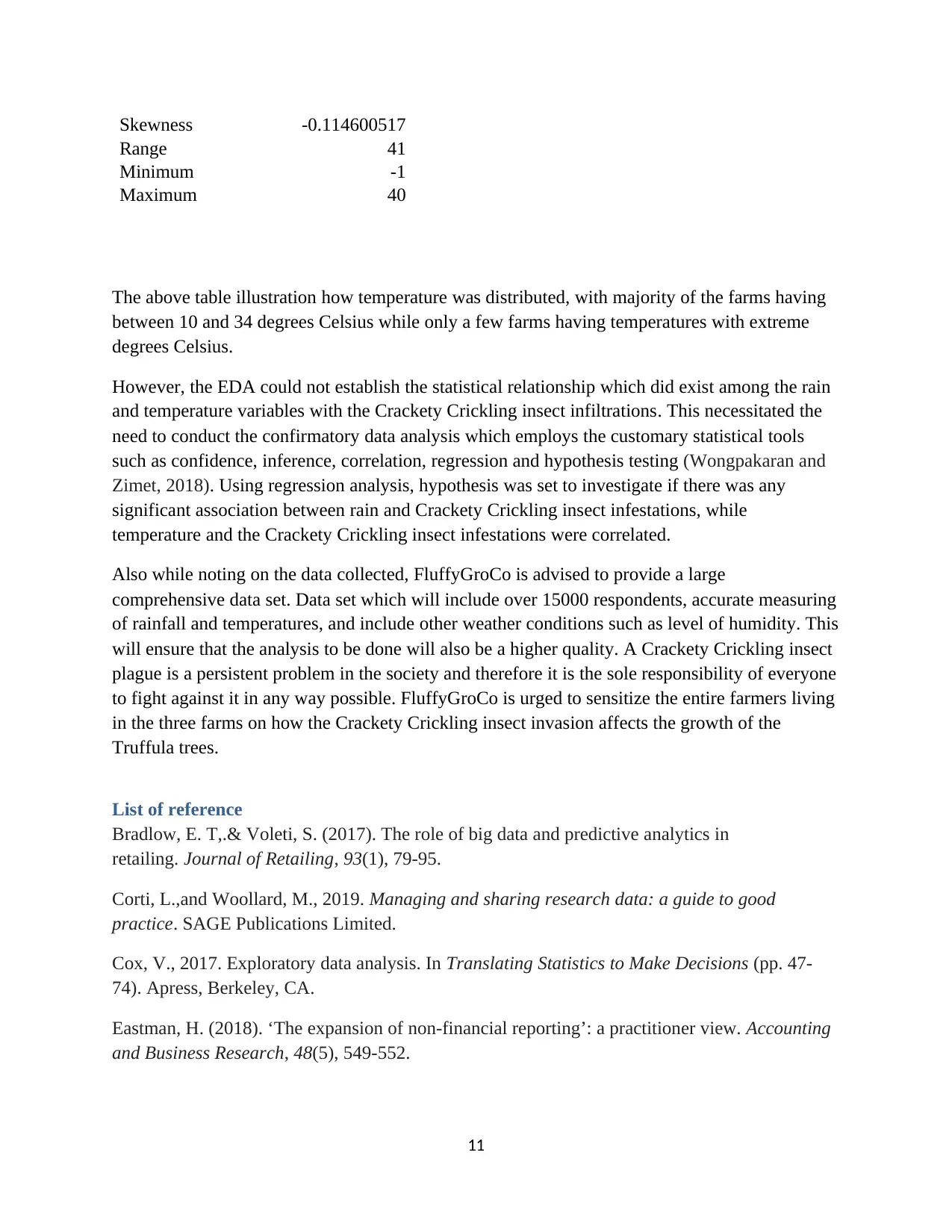
Skewness -0.114600517
Range 41
Minimum -1
Maximum 40
The above table illustration how temperature was distributed, with majority of the farms having
between 10 and 34 degrees Celsius while only a few farms having temperatures with extreme
degrees Celsius.
However, the EDA could not establish the statistical relationship which did exist among the rain
and temperature variables with the Crackety Crickling insect infiltrations. This necessitated the
need to conduct the confirmatory data analysis which employs the customary statistical tools
such as confidence, inference, correlation, regression and hypothesis testing (Wongpakaran and
Zimet, 2018). Using regression analysis, hypothesis was set to investigate if there was any
significant association between rain and Crackety Crickling insect infestations, while
temperature and the Crackety Crickling insect infestations were correlated.
Also while noting on the data collected, FluffyGroCo is advised to provide a large
comprehensive data set. Data set which will include over 15000 respondents, accurate measuring
of rainfall and temperatures, and include other weather conditions such as level of humidity. This
will ensure that the analysis to be done will also be a higher quality. A Crackety Crickling insect
plague is a persistent problem in the society and therefore it is the sole responsibility of everyone
to fight against it in any way possible. FluffyGroCo is urged to sensitize the entire farmers living
in the three farms on how the Crackety Crickling insect invasion affects the growth of the
Truffula trees.
List of reference
Bradlow, E. T,.& Voleti, S. (2017). The role of big data and predictive analytics in
retailing. Journal of Retailing, 93(1), 79-95.
Corti, L.,and Woollard, M., 2019. Managing and sharing research data: a guide to good
practice. SAGE Publications Limited.
Cox, V., 2017. Exploratory data analysis. In Translating Statistics to Make Decisions (pp. 47-
74). Apress, Berkeley, CA.
Eastman, H. (2018). ‘The expansion of non-financial reporting’: a practitioner view. Accounting
and Business Research, 48(5), 549-552.
11
Range 41
Minimum -1
Maximum 40
The above table illustration how temperature was distributed, with majority of the farms having
between 10 and 34 degrees Celsius while only a few farms having temperatures with extreme
degrees Celsius.
However, the EDA could not establish the statistical relationship which did exist among the rain
and temperature variables with the Crackety Crickling insect infiltrations. This necessitated the
need to conduct the confirmatory data analysis which employs the customary statistical tools
such as confidence, inference, correlation, regression and hypothesis testing (Wongpakaran and
Zimet, 2018). Using regression analysis, hypothesis was set to investigate if there was any
significant association between rain and Crackety Crickling insect infestations, while
temperature and the Crackety Crickling insect infestations were correlated.
Also while noting on the data collected, FluffyGroCo is advised to provide a large
comprehensive data set. Data set which will include over 15000 respondents, accurate measuring
of rainfall and temperatures, and include other weather conditions such as level of humidity. This
will ensure that the analysis to be done will also be a higher quality. A Crackety Crickling insect
plague is a persistent problem in the society and therefore it is the sole responsibility of everyone
to fight against it in any way possible. FluffyGroCo is urged to sensitize the entire farmers living
in the three farms on how the Crackety Crickling insect invasion affects the growth of the
Truffula trees.
List of reference
Bradlow, E. T,.& Voleti, S. (2017). The role of big data and predictive analytics in
retailing. Journal of Retailing, 93(1), 79-95.
Corti, L.,and Woollard, M., 2019. Managing and sharing research data: a guide to good
practice. SAGE Publications Limited.
Cox, V., 2017. Exploratory data analysis. In Translating Statistics to Make Decisions (pp. 47-
74). Apress, Berkeley, CA.
Eastman, H. (2018). ‘The expansion of non-financial reporting’: a practitioner view. Accounting
and Business Research, 48(5), 549-552.
11
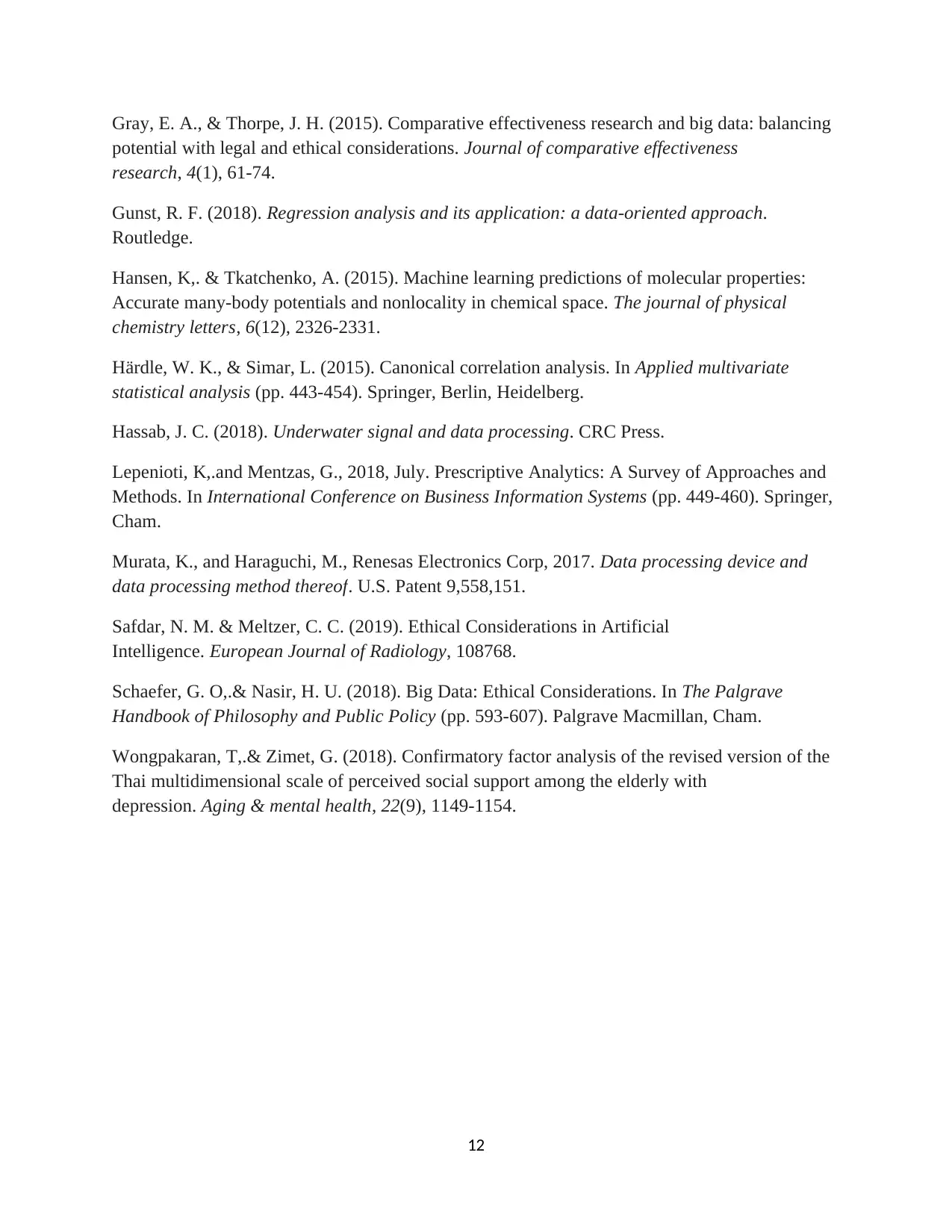
Gray, E. A., & Thorpe, J. H. (2015). Comparative effectiveness research and big data: balancing
potential with legal and ethical considerations. Journal of comparative effectiveness
research, 4(1), 61-74.
Gunst, R. F. (2018). Regression analysis and its application: a data-oriented approach.
Routledge.
Hansen, K,. & Tkatchenko, A. (2015). Machine learning predictions of molecular properties:
Accurate many-body potentials and nonlocality in chemical space. The journal of physical
chemistry letters, 6(12), 2326-2331.
Härdle, W. K., & Simar, L. (2015). Canonical correlation analysis. In Applied multivariate
statistical analysis (pp. 443-454). Springer, Berlin, Heidelberg.
Hassab, J. C. (2018). Underwater signal and data processing. CRC Press.
Lepenioti, K,.and Mentzas, G., 2018, July. Prescriptive Analytics: A Survey of Approaches and
Methods. In International Conference on Business Information Systems (pp. 449-460). Springer,
Cham.
Murata, K., and Haraguchi, M., Renesas Electronics Corp, 2017. Data processing device and
data processing method thereof. U.S. Patent 9,558,151.
Safdar, N. M. & Meltzer, C. C. (2019). Ethical Considerations in Artificial
Intelligence. European Journal of Radiology, 108768.
Schaefer, G. O,.& Nasir, H. U. (2018). Big Data: Ethical Considerations. In The Palgrave
Handbook of Philosophy and Public Policy (pp. 593-607). Palgrave Macmillan, Cham.
Wongpakaran, T,.& Zimet, G. (2018). Confirmatory factor analysis of the revised version of the
Thai multidimensional scale of perceived social support among the elderly with
depression. Aging & mental health, 22(9), 1149-1154.
12
potential with legal and ethical considerations. Journal of comparative effectiveness
research, 4(1), 61-74.
Gunst, R. F. (2018). Regression analysis and its application: a data-oriented approach.
Routledge.
Hansen, K,. & Tkatchenko, A. (2015). Machine learning predictions of molecular properties:
Accurate many-body potentials and nonlocality in chemical space. The journal of physical
chemistry letters, 6(12), 2326-2331.
Härdle, W. K., & Simar, L. (2015). Canonical correlation analysis. In Applied multivariate
statistical analysis (pp. 443-454). Springer, Berlin, Heidelberg.
Hassab, J. C. (2018). Underwater signal and data processing. CRC Press.
Lepenioti, K,.and Mentzas, G., 2018, July. Prescriptive Analytics: A Survey of Approaches and
Methods. In International Conference on Business Information Systems (pp. 449-460). Springer,
Cham.
Murata, K., and Haraguchi, M., Renesas Electronics Corp, 2017. Data processing device and
data processing method thereof. U.S. Patent 9,558,151.
Safdar, N. M. & Meltzer, C. C. (2019). Ethical Considerations in Artificial
Intelligence. European Journal of Radiology, 108768.
Schaefer, G. O,.& Nasir, H. U. (2018). Big Data: Ethical Considerations. In The Palgrave
Handbook of Philosophy and Public Policy (pp. 593-607). Palgrave Macmillan, Cham.
Wongpakaran, T,.& Zimet, G. (2018). Confirmatory factor analysis of the revised version of the
Thai multidimensional scale of perceived social support among the elderly with
depression. Aging & mental health, 22(9), 1149-1154.
12
⊘ This is a preview!⊘
Do you want full access?
Subscribe today to unlock all pages.

Trusted by 1+ million students worldwide
1 out of 12
Your All-in-One AI-Powered Toolkit for Academic Success.
+13062052269
info@desklib.com
Available 24*7 on WhatsApp / Email
![[object Object]](/_next/static/media/star-bottom.7253800d.svg)
Unlock your academic potential
Copyright © 2020–2025 A2Z Services. All Rights Reserved. Developed and managed by ZUCOL.

